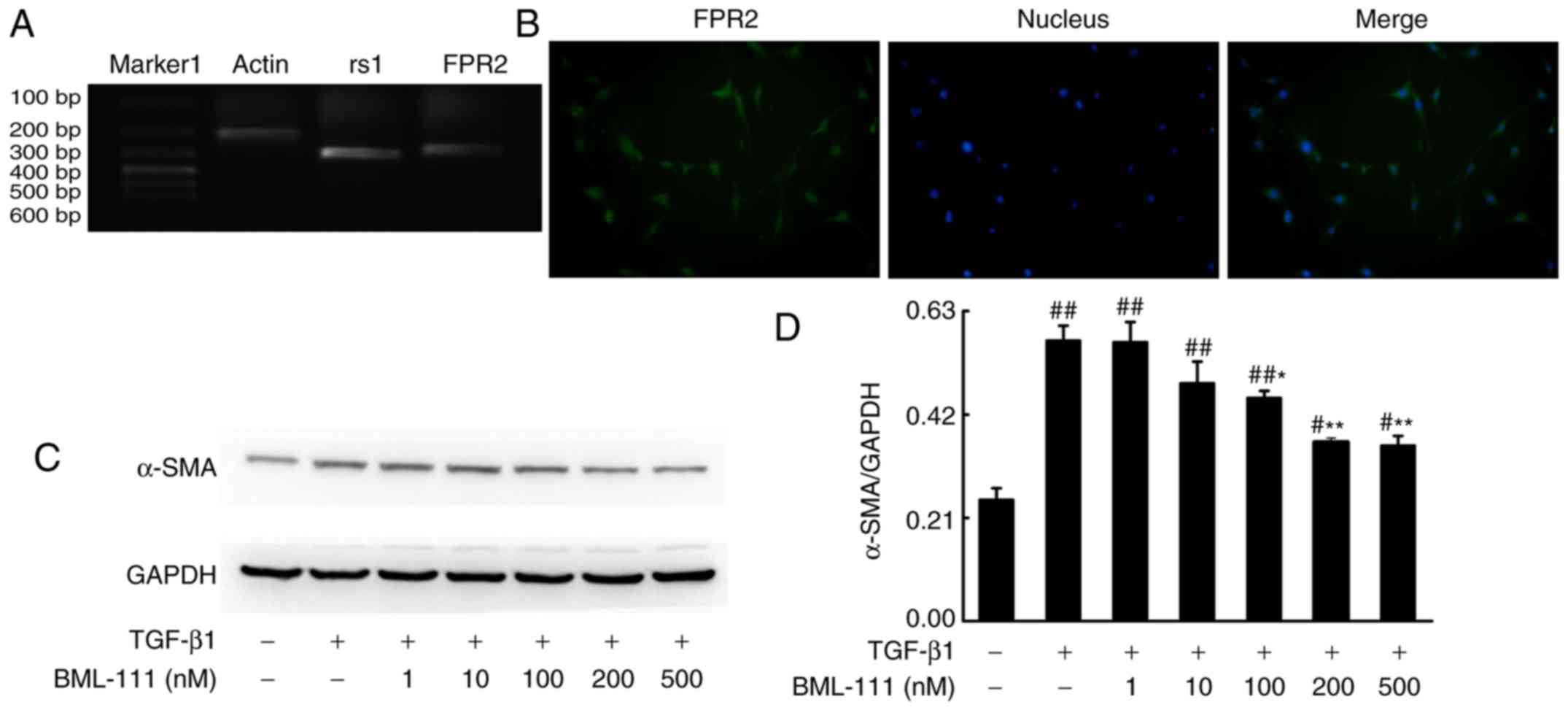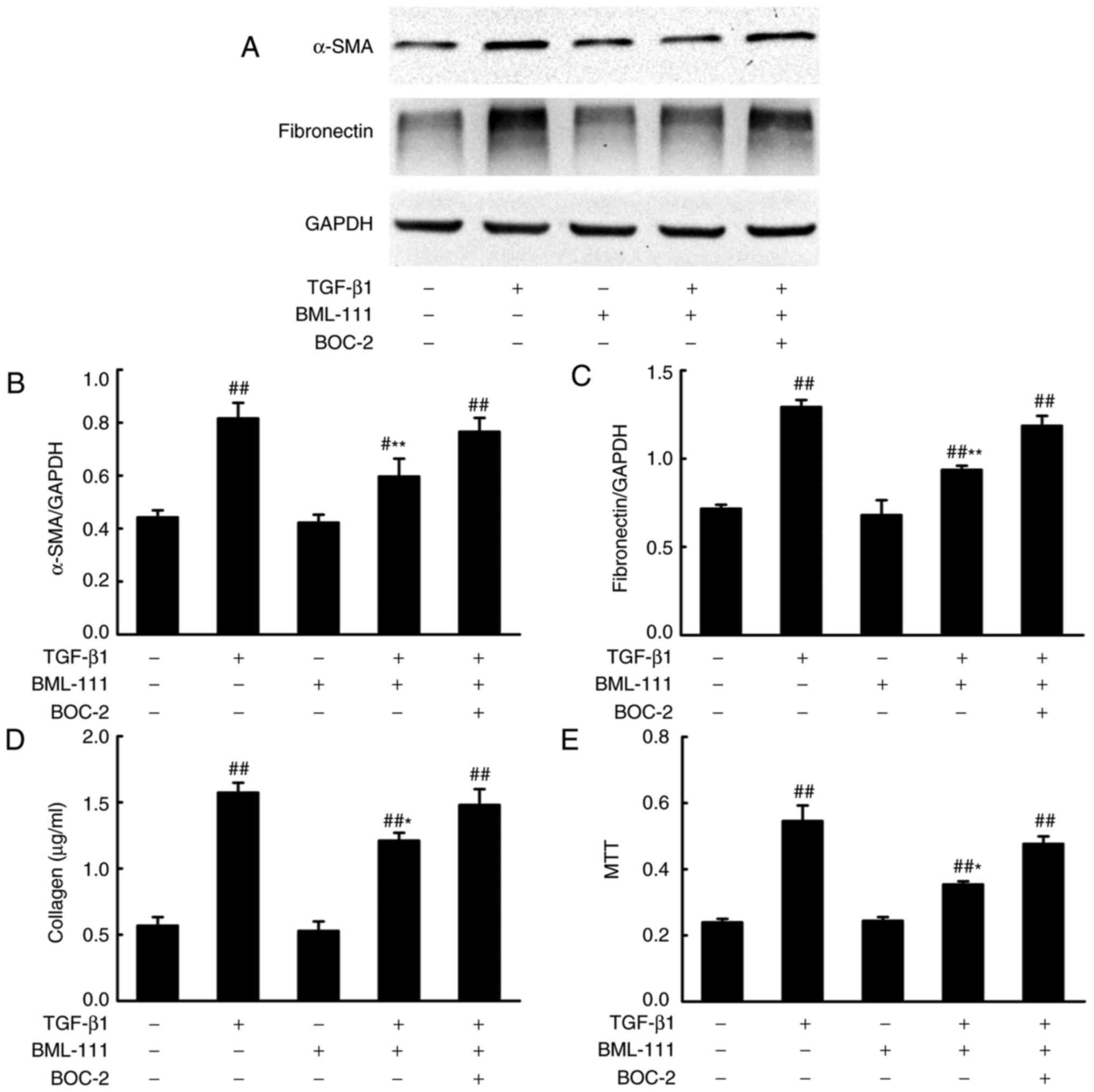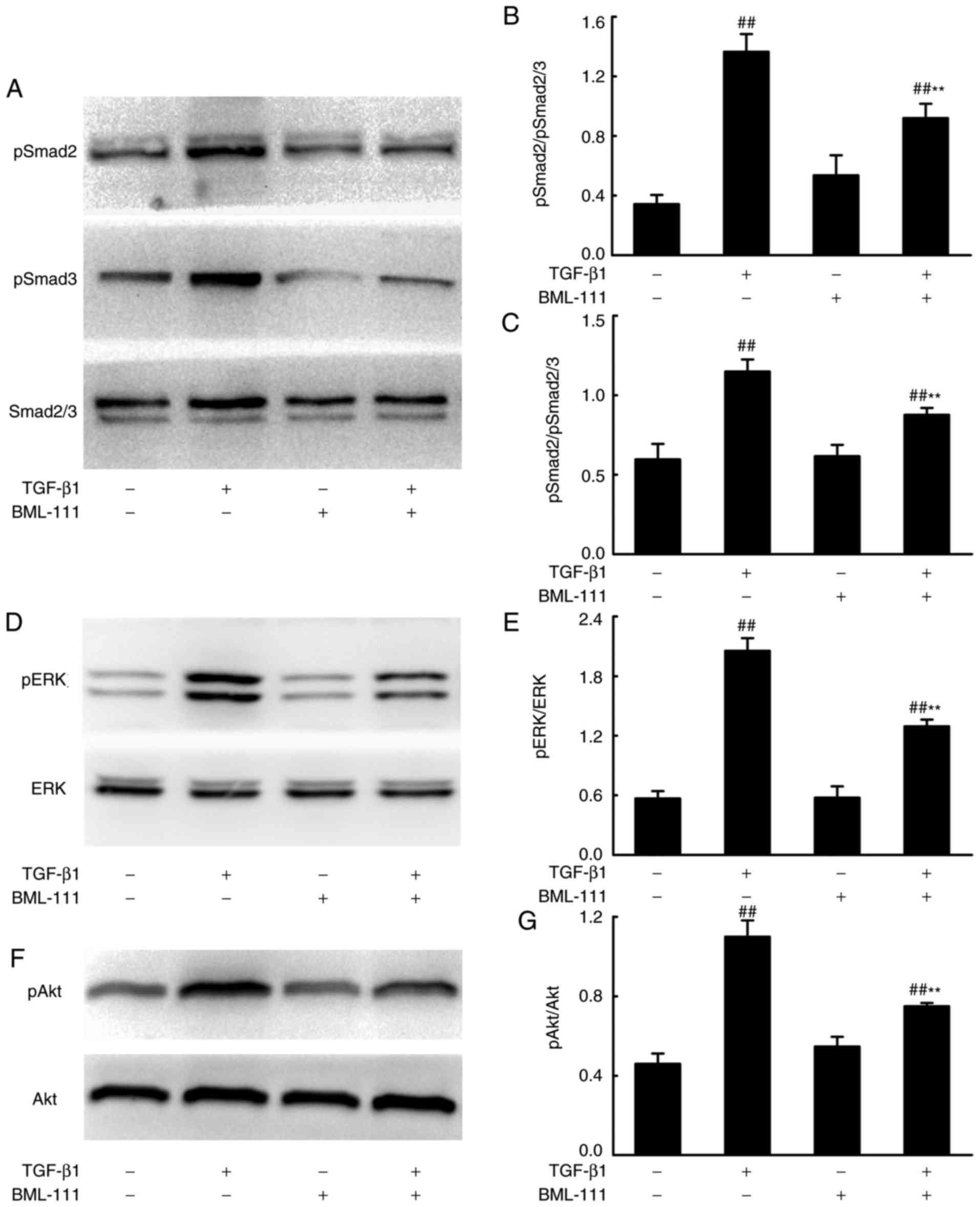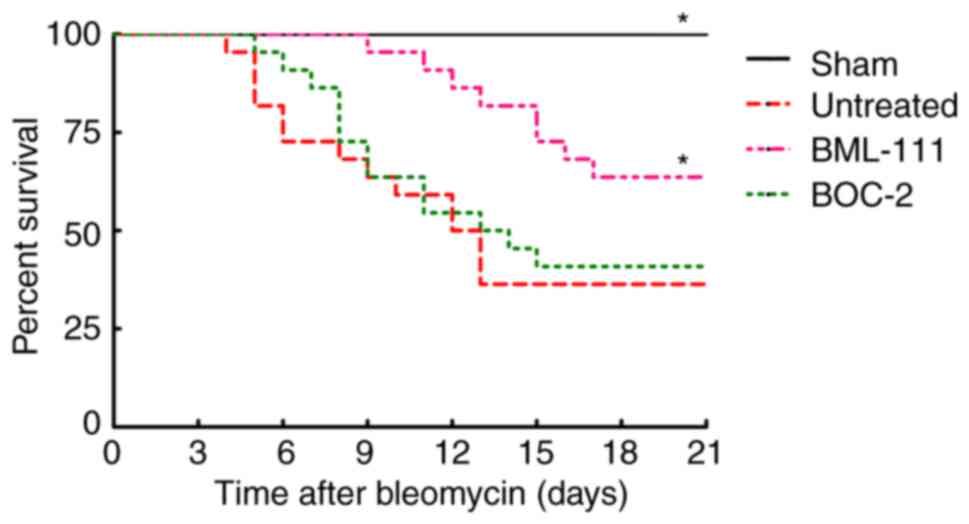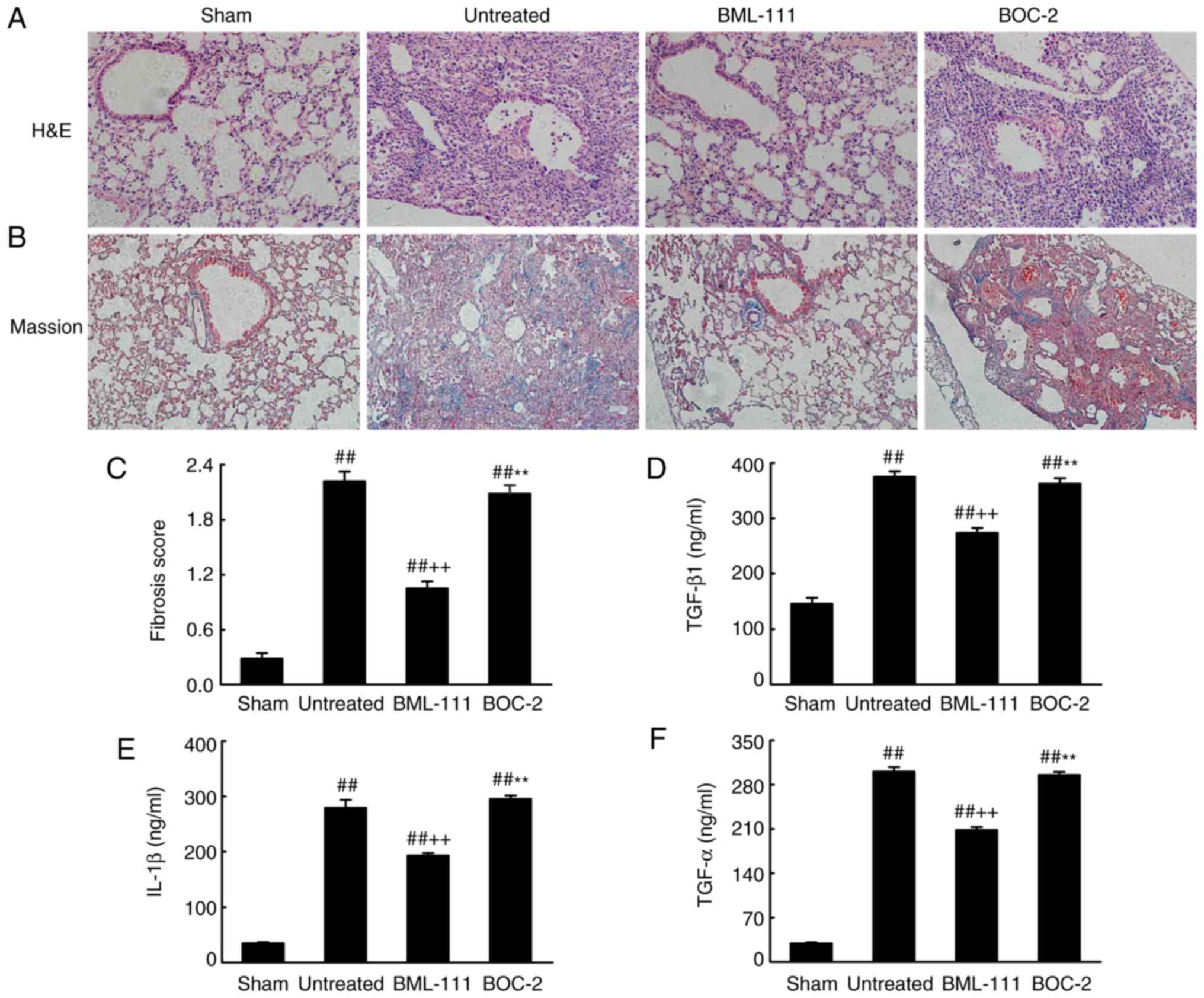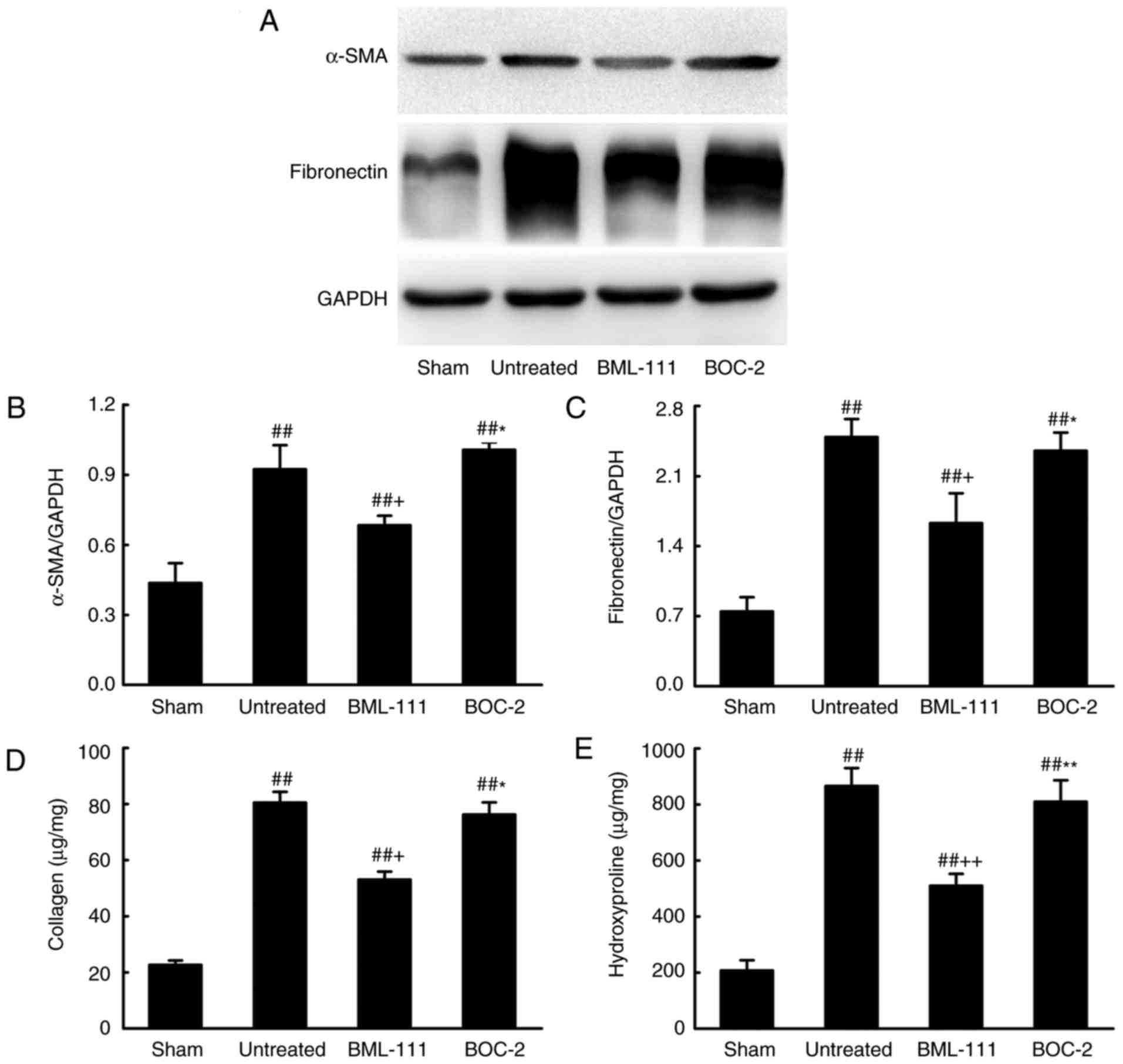|
1
|
King TJ Jr, Tooze JA, Schwarz MI, Brown KR
and Cherniack RM: Predicting survival in idiopathic pulmonary
fibrosis: Scoring system and survival model. Am J Respir Crit Care
Med. 164:1171–1181. 2001. View Article : Google Scholar : PubMed/NCBI
|
|
2
|
Dempsey OJ: Clinical review: Idiopathic
pulmonary fibrosis-past, present and future. Respir Med.
100:1871–1885. 2006. View Article : Google Scholar : PubMed/NCBI
|
|
3
|
Noble PW, Barkauskas CE and Jiang D:
Pulmonary fibrosis: Patterns and perpetrators. J Clin Invest.
122:2756–2762. 2012. View
Article : Google Scholar : PubMed/NCBI
|
|
4
|
du Bois RM: Strategies for treating
idiopathic pulmonary fibrosis. Nat Rev Drug Discov. 9:129–140.
2010. View
Article : Google Scholar : PubMed/NCBI
|
|
5
|
Wynn TA: Cellular and molecular mechanisms
of fibrosis. J Pathol. 214:199–210. 2008. View Article : Google Scholar
|
|
6
|
Wynn TA: Integrating mechanisms of
pulmonary fibrosis. J Exp Med. 208:1339–1350. 2011. View Article : Google Scholar : PubMed/NCBI
|
|
7
|
Todd NW, Luzina IG and Atamas SP:
Molecular and cellular mechanisms of pulmonary fibrosis.
Fibrogenesis Tissue Repair. 5:112012. View Article : Google Scholar : PubMed/NCBI
|
|
8
|
Phan SH: Biology of fibroblasts and
myofibroblasts. Proc Am Thorac Soc. 5:334–337. 2008. View Article : Google Scholar : PubMed/NCBI
|
|
9
|
Cutroneo KR, White SL, Phan SH and Ehrlich
HP: Therapies for bleomycin induced lung fibrosis through
regulation of TGF-beta1 induced collagen gene expression. J Cell
Physiol. 211:585–589. 2007. View Article : Google Scholar : PubMed/NCBI
|
|
10
|
Sivakumar P, Ntolios P, Jenkins G and
Laurent G: Into the matrix: Targeting fibroblasts in pulmonary
fibrosis. Curr Opin Pulm Med. 18:462–469. 2012. View Article : Google Scholar : PubMed/NCBI
|
|
11
|
Lee CG, Cho S, Homer RJ and Elias JA:
Genetic control of transforming growth factor-beta1-induced
emphysema and fibrosis in the murine lung. Proc Am Thorac Soc.
3:476–477. 2006. View Article : Google Scholar : PubMed/NCBI
|
|
12
|
Caraci F, Gili E, Calafiore M, Failla M,
La Rosa C, Crimi N, Sortino MA, Nicoletti F, Copani A and Vancheri
C: TGF-beta1 targets the GSK-3beta/beta-catenin pathway via ERK
activation in the transition of human lung fibroblasts into
myofibroblasts. Pharmacol Res. 57:274–282. 2008. View Article : Google Scholar : PubMed/NCBI
|
|
13
|
Wynn TA and Ramalingam TR: Mechanisms of
fibrosis: Therapeutic translation for fibrotic disease. Nat Med.
18:1028–1040. 2012. View
Article : Google Scholar : PubMed/NCBI
|
|
14
|
Pourgholamhossein F, Rasooli R,
Pournamdari M, Pourgholi L, Samareh-Fekri M, Ghazi-Khansari M,
Iranpour M, Poursalehi HR, Heidari MR and Mandegary A: Pirfenidone
protects against paraquat-induced lung injury and fibrosis in mice
by modulation of inflammation, oxidative stress, and gene
expression. Food Chem Toxicol. 112:39–46. 2018. View Article : Google Scholar
|
|
15
|
Romano M, Cianci E, Simiele F and
Recchiuti A: Lipoxins and aspirin-triggered lipoxins in resolution
of inflammation. Eur J Pharmacol. 760:49–63. 2015. View Article : Google Scholar : PubMed/NCBI
|
|
16
|
Xia J, Zhou XL, Zhao Y, Zhu YQ, Jiang S
and Ni SZ: Roles of lipoxin A4 in preventing paracetamol-induced
acute hepatic injury in a rabbit model. Inflammation. 36:1431–1439.
2013. View Article : Google Scholar : PubMed/NCBI
|
|
17
|
Jiang X, Li Z, Jiang S, Tong X, Zou X,
Wang W, Zhang Z, Wu L and Tian D: Lipoxin A4 exerts protective
effects against experimental acute liver failure by inhibiting the
NF-κB pathway. Int J Mol Med. 37:773–780. 2016. View Article : Google Scholar : PubMed/NCBI
|
|
18
|
Börgeson E, Docherty NG, Murphy M, Rodgers
K, Ryan A, O’Sullivan TP, Guiry PJ, Goldschmeding R, Higgins DF and
Godson C: Lipoxin A4 and benzolipoxin A4
attenuate experimental renal fibrosis. FASEB J. 25:2967–2979. 2011.
View Article : Google Scholar
|
|
19
|
Krönke G, Reich N, Scholtysek C,
Akhmetshina A, Uderhardt S, Zerr P, Palumbo K, Lang V, Dees C,
Distler O, et al: The 12/15-lipoxygenase pathway counteracts
fibroblast activation and experimental fibrosis. Ann Rheum Dis.
71:1081–1087. 2012. View Article : Google Scholar : PubMed/NCBI
|
|
20
|
Martins V, Valença SS, Farias-Filho FA,
Molinaro R, Simões RL, Ferreira TPE, Silva PM, Hogaboam CM, Kunkel
SL, Fierro IM, et al: ATLa, an aspirin-triggered lipoxin A4
synthetic analog, prevents the inflammatory and fibrotic effects of
bleomycin-induced pulmonary fibrosis. J Immunol. 182:5374–5381.
2009. View Article : Google Scholar : PubMed/NCBI
|
|
21
|
Gong J, Guo S, Li HB, Yuan SY, Shang Y and
Yao SL: BML-111, a lipoxin receptor agonist, protects haemorrhagic
shock-induced acute lung injury in rats. Resuscitation. 83:907–912.
2012. View Article : Google Scholar : PubMed/NCBI
|
|
22
|
Fiore S, Maddox JF, Perez HD and Serhan
CN: Identification of a human cDNA encoding a functional high
affinity lipoxin A4 receptor. J Exp Med. 180:253–260. 1994.
View Article : Google Scholar : PubMed/NCBI
|
|
23
|
Takano T, Fiore S, Maddox JF, Brady HR,
Petasis NA and Serhan CN: Aspirin-triggered 15-epilipoxin A4 (LXA4)
and LXA4 stable analogues are potent inhibitors of acute
inflammation: Evidence for anti-inflammatory receptors. J Exp Med.
185:1693–1704. 1997. View Article : Google Scholar : PubMed/NCBI
|
|
24
|
Gao JL, Chen H, Filie JD, Kozak CA and
Murphy PM: Differential expansion of the N-formylpeptide receptor
gene cluster in human and mouse. Genomics. 51:270–276. 1998.
View Article : Google Scholar : PubMed/NCBI
|
|
25
|
Wang YP, Wu Y, Li LY, Zheng J, Liu RG,
Zhou JP, Yuan SY, Shang Y and Yao SL: Aspirin-triggered lipoxin A4
attenuates LPS-induced pro-inflammatory responses by inhibiting
activation of NF-κB and MAPKs in BV-2 microglial cells. J
Neuroinflammation. 8:952011. View Article : Google Scholar
|
|
26
|
Lee TH, Lympany P, Crea AE and Spur BW:
Inhibition of leukotriene B4-induced neutrophil migration by
lipoxin A4: structure-function relationships. Biochem Biophys Res
Commun. 180:1416–1421. 1991. View Article : Google Scholar : PubMed/NCBI
|
|
27
|
Li HB, Wang GZ, Gong J, Wu ZY, Guo S, Li
B, Liu M, Ji YD, Tang M, Yuan SY, et al: BML-111 attenuates
hemorrhagic shock-induced acute lung injury through inhibiting
activation of mitogen-activated protein kinase pathway in rats. J
Surg Res. 183:710–719. 2013. View Article : Google Scholar : PubMed/NCBI
|
|
28
|
Gong J, Li HB, Guo S, Shang Y and Yao SL:
Lipoxin receptor agonist, may be a potential treatment for
hemorrhagic shock-induced acute lung injury. Med Hypotheses.
79:92–94. 2012. View Article : Google Scholar : PubMed/NCBI
|
|
29
|
Li H, Wu Z, Feng D, Gong J, Yao C, Wang Y,
Yuan S, Yao S and Shang Y: BML-111, a lipoxin receptor agonist,
attenuates ventilator-induced lung injury in rats. Shock.
41:311–316. 2014. View Article : Google Scholar
|
|
30
|
Zhou XY, Yu ZJ, Yan D, Wang HM, Huang YH,
Sha J, Xu FY, Cai ZY and Min WP: BML-11, a lipoxin receptor
agonist, protected carbon tetrachloride-induced hepatic fibrosis in
rats. Inflammation. 36:1101–1106. 2013. View Article : Google Scholar : PubMed/NCBI
|
|
31
|
Izumo T, Kondo M and Nagai A: Effects of a
leukotriene B4 receptor antagonist on bleomycin-induced pulmonary
fibrosis. Eur Respir J. 34:1444–1451. 2009. View Article : Google Scholar : PubMed/NCBI
|
|
32
|
Kelly MN, Zheng M, Ruan S, Kolls J,
D’Souza A and Shellito JE: Memory CD4+ T cells are
required for optimal NK cell effector functions against the
opportunistic fungal pathogen Pneumocystis murina. J Immunol.
190:285–295. 2013. View Article : Google Scholar
|
|
33
|
Yang J, Nan C, Ripps H and Shen W:
Destructive changes in the neuronal structure of the FVB/N mouse
retina. PLoS One. 10:e1297192015.
|
|
34
|
AVMA Guodelines for the Euthanasia of
Animals. 2013.48
|
|
35
|
Ashcroft T, Simpson JM and Timbrell V:
Simple method of estimating severity of pulmonary fibrosis on a
numerical scale. J Clin Pathol. 41:467–470. 1988. View Article : Google Scholar : PubMed/NCBI
|
|
36
|
Liu J, Wei Y, Luo Q, Xu F, Zhao Z, Zhang
H, Lu L, Sun J, Liu F, Du X, et al: Baicalin attenuates
inflammation in mice with OVA-induced asthma by inhibiting NF-κB
and suppressing CCR7/CCL19/CCL21. Int J Mol Med. 38:1541–1548.
2016. View Article : Google Scholar : PubMed/NCBI
|
|
37
|
Tang M, Chen L, Li B, Wang Y, Li S, Wen A,
Yao S and Shang Y: BML-111 attenuates acute lung injury in
endotoxemic mice. J Surg Res. 200:619–630. 2016. View Article : Google Scholar
|
|
38
|
Roach KM, Feghali-Bostwick CA, Amrani Y
and Bradding P: Lipoxin A4 Attenuates constitutive and
TGF-β1-dependent profibrotic activity in human lung myofibroblasts.
J Immunol. 195:2852–2860. 2015. View Article : Google Scholar : PubMed/NCBI
|
|
39
|
Wu SH, Wu XH, Lu C, Dong L and Chen ZQ:
Lipoxin A4 inhibits proliferation of human lung fibroblasts induced
by connective tissue growth factor. Am J Respir Cell Mol Biol.
34:65–72. 2006. View Article : Google Scholar
|
|
40
|
Mendoza JA, Jacob Y, Cassonnet P and Favre
M: Human papillomavirus type 5 E6 oncoprotein represses the
transforming growth factor beta signaling pathway by binding to
SMAD3. J Virol. 80:12420–12424. 2006. View Article : Google Scholar : PubMed/NCBI
|
|
41
|
Hasegawa M, Matsushita Y, Horikawa M,
Higashi K, Tomigahara Y, Kaneko H, Shirasaki F, Fujimoto M,
Takehara K and Sato S: A novel inhibitor of Smad-dependent
transcriptional activation suppresses tissue fibrosis in mouse
models of systemic sclerosis. Arthritis Rheum. 60:3465–3475. 2009.
View Article : Google Scholar : PubMed/NCBI
|
|
42
|
Runyan CE, Schnaper HW and Poncelet AC:
The phosphatidylinositol 3-kinase/Akt pathway enhances
Smad3-stimulated mesangial cell collagen I expression in response
to transforming growth factor-beta1. J Biol Chem. 279:2632–2639.
2004. View Article : Google Scholar
|
|
43
|
Xiao L, Du Y, Shen Y, He Y, Zhao H and Li
Z: TGF-beta 1 induced fibroblast proliferation is mediated by the
FGF-2/ERK pathway. Front Biosci (Landmark Ed). 17:2667–2674. 2012.
View Article : Google Scholar
|
|
44
|
Hinz B: Myofibroblasts. Exp Eye Res.
142:56–70. 2016. View Article : Google Scholar
|
|
45
|
Mouratis MA and Aidinis V: Modeling
pulmonary fibrosis with bleomycin. Curr Opin Pulm Med. 17:355–361.
2011. View Article : Google Scholar : PubMed/NCBI
|
|
46
|
Kolb M, Margetts PJ, Anthony DC, Pitossi F
and Gauldie J: Transient expression of IL-1beta induces acute lung
injury and chronic repair leading to pulmonary fibrosis. J Clin
Invest. 107:1529–1536. 2001. View Article : Google Scholar : PubMed/NCBI
|
|
47
|
Sime PJ, Marr RA, Gauldie D, Xing Z,
Hewlett BR, Graham FL and Gauldie J: Transfer of tumor necrosis
factor-alpha to rat lung induces severe pulmonary inflammation and
patchy interstitial fibrogenesis with induction of transforming
growth factor-beta1 and myofibroblasts. Am J Pathol. 153:825–832.
1998. View Article : Google Scholar : PubMed/NCBI
|
|
48
|
Sheppard D: Transforming growth factor
beta: A central modulator of pulmonary and airway inflammation and
fibrosis. Proc Am Thorac Soc. 3:413–417. 2006. View Article : Google Scholar : PubMed/NCBI
|















